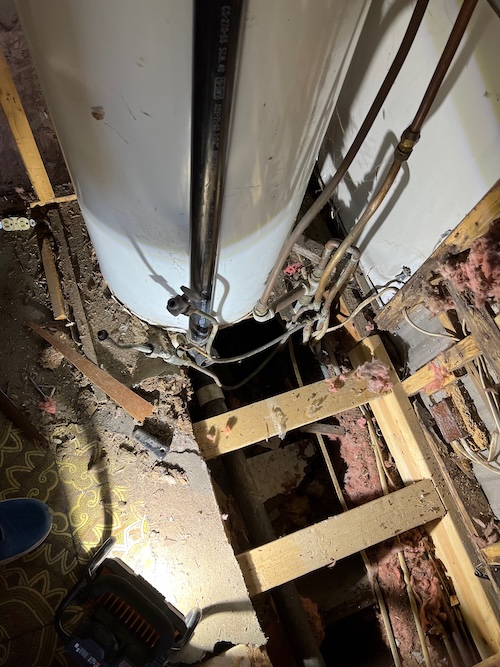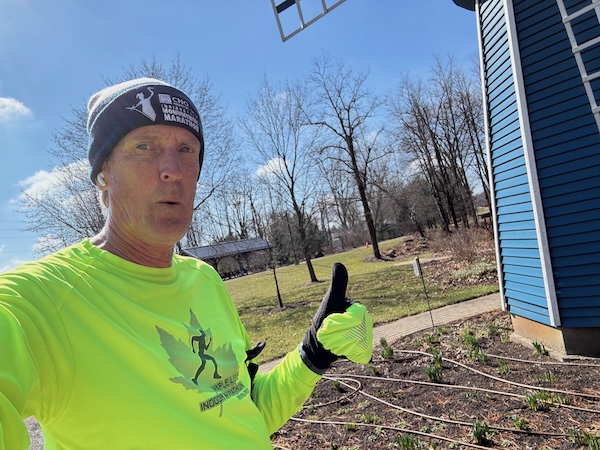Not everyone on our “what it’s like to live in a Tiny House in Tucson” tour wants the full explanation. Maybe that’s just me—I like telling the whole story. And, if this first stretch of living in Casa Saguaro has taught me anything, it’s that every small victory comes with a new challenge. Just when we get one thing fixed, another thing reminds us that we’re still in transition.

That first month, it was the electricity. Then, the plumbing. By the time we reached a point where things were stable, Lori and I started bickering. I think we were both waiting for normal to settle in, but every small win seemed to bring a new setback.
The Return to The Estate & The Rotten Egg Smell
Back in Indiana for a week, stepping into The Estate, Lori pointed something out as soon as we walked in:
“What is that smell?”
It wasn’t just the musty scent of a house closed up for weeks—it was something sulfuric, like rotten eggs. I mentally added it to my to-do list, but my focus was already on the pump house and the well pipes that had burst while we were gone.
The next morning, I smelled it again every time we turned on the hot water. I read the directions on fixing it, but I didn’t act right away. Maybe I thought it would just go away. Maybe I didn’t want to deal with one more problem. Either way, Lori sent me a link explaining how to remove the smell, and I finally started paying attention.
The House We Built (and the One We Thought Would Arrive)
The Estate was never meant to exist. It was supposed to be a temporary stop—a place to live while we waited for the tiny house we had ordered. But after delays and supply chain issues, we reached a point where we had a choice: keep waiting, or build something ourselves.

I didn’t think I had the skill set for a remodel, but with some encouragement (and a bit of necessity), I took the gutted mobile home down to its frame and started over. Insulating, re-studding, replumbing the entire thing. The water heater that now smelled like rotten eggs? I had installed that myself. And now, it was giving us problems.
“How old is the water heater?” Lori asked.
“New with the remodel.”
“Where did the old one go?”
I smiled. She already knew the answer. I had moved the old one out by myself, and it didn’t sit there long before a neighbor stopped by.
“You want that?” I asked.
“Absolutely.”
Within hours, he was back with his truck, probably stripping it for scrap metal. I could have done the same, but sometimes it’s better to let go of what no longer serves you.
Problem-Solving is a Marathon, Not a Sprint
So now I was standing in front of my “new” water heater, ready to fix the smell. I had the instructions. I had the tools. I even made a trip to Dollar General to pick up unscented bleach and a long funnel, thinking I was about to follow the standard steps:
1️⃣ Turn off the breaker.
2️⃣ Shut off the incoming water.
3️⃣ Drain the 50-gallon tank.
4️⃣ Clean everything out.
But before I started, I checked the online manual. Was there another way?
And there it was: “If you experience a sulfur smell, turn up the temperature to 140°F to kill off the bacteria.”
No draining. No bleach. Just adjusting a setting and letting the system take care of itself. I turned the dial, let the heater run, and sure enough—the smell faded. A small adjustment solved the problem.
Pacing, Adjustment, and Trusting the Process

On my run that afternoon, I noticed something familiar. The Pumpkinvine Trail seemed the same but different. I had only taken a few days off, but I could feel it in my legs. The first mile was slow, but by the second mile, I was back in rhythm. That’s how running works. That’s how problem-solving works.
I used to get impatient with my own runs, wanting to push through discomfort too soon. But after years of training, I’ve learned that you have to warm up, adjust, and let the process unfold.
Fixing the water heater wasn’t about finding a perfect solution right away. It was about stepping into the process, reading, adjusting, and trusting that forward motion would get me there.
Lessons from Water Heaters and Running Trails
✔ Not every problem requires an extreme solution. Sometimes, small adjustments work better than a complete overhaul.
✔ Patience and process matter. Whether it’s training for a marathon, fixing a house, or adjusting to change, we have to trust that momentum builds over time.
✔ We don’t have to do everything the hardest way possible. Sometimes, we overcomplicate things just because we assume they should be difficult. What if we just checked the manual first?
Maybe that’s the lesson for today: Some fixes don’t come from force—they come from understanding what’s really needed and giving it time to work.
